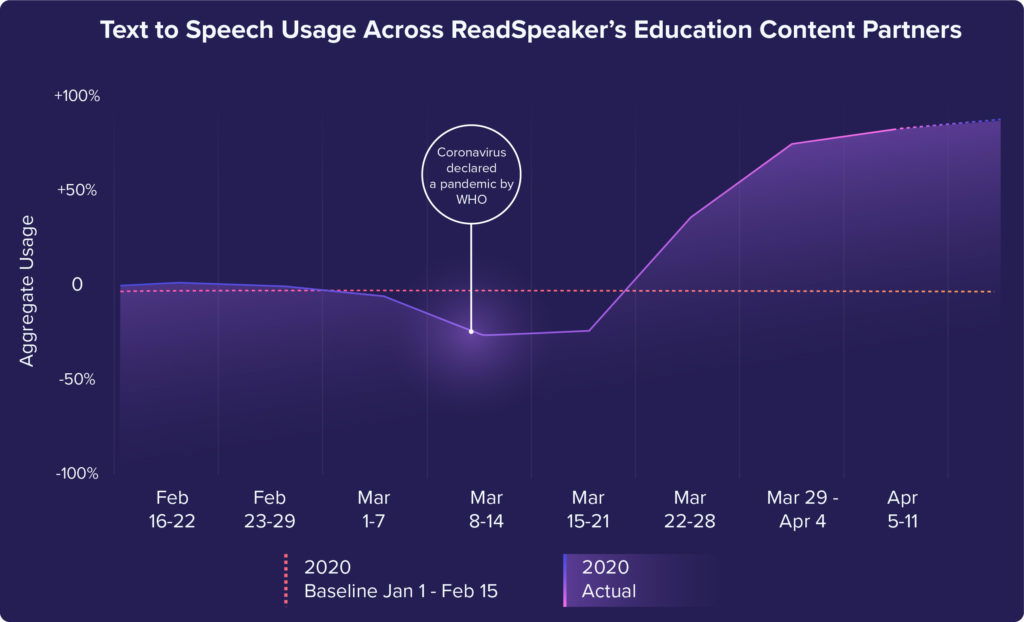
The COVID-19 pandemic led to a sea of change in the education realm. Around the world, teachers, parents, and students — including those in K-12 schools and continuing education — were forced into distance learning in what felt like an instant.
While many students are now returning to in-person classrooms, online learning — which refers to any learning that occurs on the web — is only ramping up. Plus, the distance learning technologies used for remote education certainly haven’t gone away. Distance learning and coronavirus have made a permanent impact on educational courses around the world. In this article, we’ll explore the shift in mindset that occurred during and after school closures, what the future of distance learning will look like, and how to engage students in online learning as we move forward.
Download our ebook ‘Designing for Difference’ for more information on how to design effective online courses.
Download
How Distance Learning and Coronavirus Affected Education
As traditional classes suddenly became distance learning courses, schools scrambled to find ways to adapt to the new educational environment.
One of the most important results of this unexpected shift was the movement of distance learning technology into the mainstream. These tools, which were once lesser known or appeared too complicated to use, proved to be hugely beneficial for all.
At ReadSpeaker, we saw clear evidence of this shifting mindset. We experienced an unprecedented increase in the usage of our text-to-speech (TTS) tools, which are an integral part of making distance learning systems more accessible to and effective for diverse students.

In March 2020, when distance learning began to rise exponentially, ReadSpeaker observed a marked increase in text to speech usage compared to March of 2019, including:
- A 32% increase across textbook publisher integrations
- A 44% increase among institutions where ReadSpeaker is integrated into the learning management system (LMS)
- A 165% increase from LMS data specific to Italy, with one university showing a 100% spike
As new tools were implemented, educators realized that distance teaching technology isn’t a replacement for their expertise; it’s a means for empowering students to discover new learning styles.
With distance learning software, educational institutions were better able to embrace Universal Design for Learning (UDL), a framework that supports students’ individual needs to give every learner equal opportunity to thrive. Many distance learning technologies offer far more benefits than simply the ability to learn remotely.
Today, many educators recognize that online learning can be a key piece that completes the educational puzzle. As schools return to traditional course structures, many educators are continuing to implement distance learning software (and other online technologies) in their classrooms to blend the benefits of virtual and in-person curriculums.
The Future of Distance Learning Technology
While many experts predicted a short-term spike in the use of distance learning technology during the pandemic, it’s become clear that it’s here to stay. The sudden shift to distance learning pushed schools to invest in laptops for remote students at a record pace; one-to-one computing has now doubled compared to pre-pandemic levels. This has laid the foundation for online learning in the classroom.
Now that parents, students, and teachers have all become familiar with distance learning tools — and have devices with distance learning software installed— blended learning will be the natural next step for many educational institutions. Just as Zoom became ubiquitous as a communication tool due to the COVID-19 crisis, distance learning tools (and other e-learning software) will become ubiquitous in education. Learners will expect that the new software they’ve been exposed to will be incorporated into courses moving forward. Administrators and institutions will need to ensure they are meeting the changing expectations of today’s tech-savvy learners.
As an example, text to speech, which was largely used for teaching students with disabilities during the distance learning era, will be offered to the more diverse populations that can benefit from the technology. Second language learners, for instance, can tap into TTS tools to practice pronunciation. The future of distance learning technology will include more widespread implementation.
We can also expect to see digital education tools evolve more rapidly. Distance and online learning technology is no longer niche, which means demand is strong enough for fast-paced research and development. However, accessibility will remain an exceedingly important topic for educators.
Accessibility in the Online Learning Future
When distance learning became more mainstream, so did the concepts of accessibility and equal access. These terms were no longer limited to the awareness of disability department leaders. The more online learning becomes integrated into students’ lives, the more evident it becomes that many educational courses aren’t built for every student. For instance, content isn’t always compatible with screen readers, and school administrators who aren’t trained in accessibility don’t always recognize the right accommodations to provide.
However, as we move into the online learning future, the rising conversation surrounding accessibility will encourage the continued adoption of online and distance learning tools. Schools will increasingly recognize that digital tools allow accessibility to be addressed more effectively and efficiently than in technology-free classrooms. For example, instead of having someone manually read text aloud, schools can automate the process and easily offer audio learning options to students who need it.
Solving accessibility challenges in the digital space will also help educators begin to solve the issue of disengagement in online learning.
How to Engage Students in Online Learning
Among the many challenges posed by the rise of distance learning and coronavirus was how to engage students in online learning. Today, this challenge still stands. Even inside a traditional classroom, educators and learners must combat distractions and the demotivation that occurs with limited teacher-student interaction.
The continued growth of online learning demands changes to course structure and content, as well as enhanced support for diverse student needs. Here are five approaches that can help students stay actively engaged with their educational materials online.
1. Enlist the help of instructional designers.
Transforming courses for the digital space isn’t as simple as uploading slideshows to an online learning platform or presenting lectures over video calls. Online learning-friendly courses must be structured in an entirely new way that assists students who struggle to stay focused.
Instructional designers can offer immense support at the beginning of and during the course design process. Rather than leaving traditional classroom teachers to navigate blended learning on their own, these professionals can offer tips and resources for meeting the unique needs of learners, including action-oriented task ideas and educational technology tools.
2. Actively connect students to learning materials.
When students are required to stare at the same screen for long periods of time, they struggle to combat the distractions around them. Online learning curriculum must be dynamic to capture the attention of all learners and regularly draw in those who disengage. Dynamic curriculums tend to include shorter classes or more frequent breaks, and encourage educators to frequently check in with students and offer guiding questions.
3. Encourage social interaction.
The lack of social interaction between students during the COVID-19 pandemic led to decreased satisfaction, boredom, and declines in mental health. All of the above can contribute to decreased engagement in online learning if students are made to focus exclusively on their screens.
Prioritizing moments of social exchange is an important factor to consider when designing a blended course. Engaged students should still feel connected to the peers in their classrooms, even if they’re working independently online.
4. Leverage tools that enhance accessibility.
As Poverty Action Lab states, one of the steps to keeping students engaged in online learning is to maximize access to material for all students.
Educational tools can be used to make content both accessible for those with difficulties and engaging for everyone. Audio is one of these tools. Recorded classes, audio, and voice-enhanced content play an important part in online course design by helping diverse students better engage in and process course materials.
Tools like exam proctoring software can also help students feel like they’re on the same playing field by promoting fairness in the classroom.
5. Implement text to speech.
Voice is an effective tool to keep students engaged no matter where they are, what they are studying, or what resources they are using. Whether for K-12, post-graduate, continuing, or corporate education, audio allows users to remain engaged and focused on content. Having text read out loud also assists learners with decoding issues — helping them concentrate on the content — and gives those who prefer to listen a better way to engage in learning materials.
Text to speech enhances a wide variety of content, such as coursework, publishing resources, personal reading and textbooks, corporate archives, manuals, and any type of online learning text.
As students, administrators, teachers, and parents embrace and apply the advantages of blended learning and the distance learning tools they implemented during the pandemic, the use of text to speech will grow as a way to keep students engaged in online learning.
We’re here to answer any questions.
Contact us
Amy Foxwell is an education technology strategist with over 20 year’s deep expertise in accessibility and digital inclusion.
At ReadSpeaker, she helps schools, universities, and corporate learning teams integrate text-to-speech solutions that improve outcomes, support diverse learners, and ensure compliance with accessibility standards.
Amy’s work is driven by a belief that every learner—whether in the classroom, on campus, or in the workplace—deserves equal access to knowledge, and that thoughtful use of technology can make that possible.


